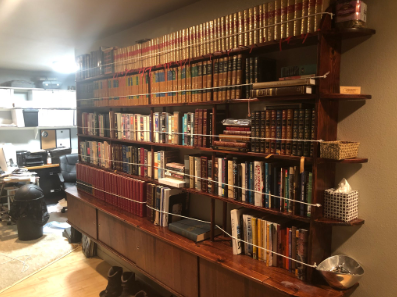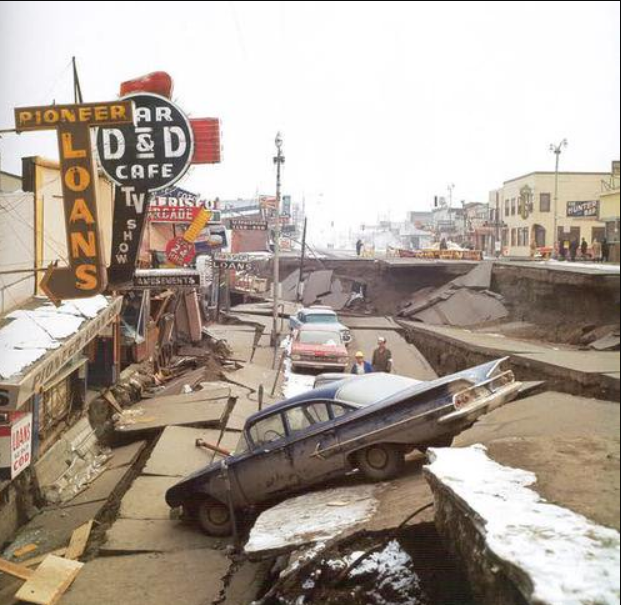The Big One Sensitized Me!
Update on story first appearing in ECHO Magazine, January 10, 2019

Living in a part of the world where earthquakes are a frequent occurrence requires an understanding of what causes them and how to deal with what results when the earth starts shaking violently.
Much has been learned about earthquakes since Alaska’s Big One, and some of us have faith in our survival when they occur.
Check out most recent Alaska Earthquakes here:

https://earthquake.alaska.edu/earthquakes/recent_list
For me, aftershocks from a major earthquake can be particularly unnerving. The Big One was my first major earthquake–the most massive earthquake in North American history– on March 27, 1964, at 5:36 p.m. local time. The magnitude was 9.2, with epicenter in the Prince William Sound region of the new state. This was the second largest earthquake ever recorded, next to the M9.5 earthquake in Chile in 1960.
[1]Earthquake Facts, USGS.

I doubt I could tell the difference between a 9.2 and a 9.5 earthquake; after all these years only I know that it the Big One lasted longer than our recent 7.0 shaker, but I don’t think that the jerking was more intense.
For background: My father had come to Alaska from New Mexico to work as a civilian contractor on the White Alice System. At the time of the 1964 quake, my two siblings, stepmother, and I were residing in a second story two-bedroom apartment at Martin Arms, located on a bluff which later would be mined for aggregate at 3rd Avenue and Unga Street. The solid ground under those 26 old, wooden buildings in this military-style barracks complex, assured they were well-shaken, and the brick chimneys of the various laundry facilities collapsed, but no sliding occurred and nobody there was hurt.

When the Big One struck, my father was many bush-plane-accessible-only miles away from Anchorage, playing chess with another fellow on a Good Friday evening away from their families. Pieces on the checkerboard were rattled slightly, but soon every person at that site was extremely alarmed. A ham radio operator, who apparently was broadcasting from the Turnagain Heights neighborhood, reported
that Anchorage had been leveled and few survivors were expected to be found. This upper-class neighborhood overlooking Turnagain Arm was devastated as the glacier silt base near the water’s edge lost form and slid, causing one square kilometer to sink with 75 homes.² Today that area includes an informative walking trail at Earthquake Park.
As a military outpost, with both Fort Richardson Army Post, and Elmendorf Air Force Base, Anchorage was immediately placed under martial law and residents were urged to shelter in place. Soldiers blocked off the downtown area, and no looting occurred.
Additionally, nobody could have known how this event would change the way science and technology encounter the challenge of future earthquakes and tsunamis.
Mankind has learned a lot from that earthquake.
According to the U.S. Geological Survey: At that time, scientists did not yet know precisely how or why the earthquake occurred.
Three U.S. Geological Survey (USGS) scientists were immediately sent to Alaska to figure it out. What they found marked a turning point in earthquake research. This event helped confirm the theory of plate tectonics and provided firsthand insight on earthquake processes, tsunami generation, and the impacts of these phenomena on communities, both locally and across the Pacific.
[2]Anchorage Devastation: GeoScienceWorld,
The 1964 earthquake validated a primary tenet of plate motion, according to researchers Michael E. West, Peter J. Haeussler, Natalia A. Ruppert, and Jeffrey T. Freymueller, of the Alaska Seismic Hazards Safety Commission. This elevated plate tectonics theory into textbook fact, and through additional research with advanced instruments, allowed an unprecedented view into the mechanics of giant earthquakes.
Additionally, the 1964 Alaska earthquake also served as a wake-up call regarding local tsunamis.

Previously it was believed that tsunamis mostly transited from the earthquake to other locations, as did the Alaska Quake, killing people in California. We now understand that fjord landscapes and their huge sediment loads are breeding grounds for sub-marine landslides. Even modest ground motions can trigger landslides with catastrophic tsunami consequences. Recognition of different local sources of tsunami generation makes the 1964 earthquake a watershed moment in revelations about coastal hazards.
According to the researchers above: Almost everywhere, the greatest damages were sustained, not from the direct ground shaking, but from soil failure, tsunamis, landslides, and even avalanches. Alaska’s infrastructure in 1964 was, by happenstance, relatively resilient. Wood‐frame construction, low‐rise structures, and modest urban density limited fatalities from the quake itself.
This created new realities of Alaska living. The recent 7.0 earthquake of November 30 could be considered by some as just a late-breaking aftershock. Over 54 years those of us who have lived here continuously have grown accustomed to earthquakes. We call them tremors. They serve as a reminder that the earth can become animated without notice.
And, I still avoid staying very long in tall buildings.
Sources:
Alaska
[1]Earthquake Facts: http://earthquake.usgs.gov/earthquakes/events/alaska1964/
[2]Anchorage Devastation: GeoScienceWorld, “Why the 1964 Great Alaska Earthquake Matters 50
Years Later, http://srl.geoscienceworld.org/content/85/2/245.full
